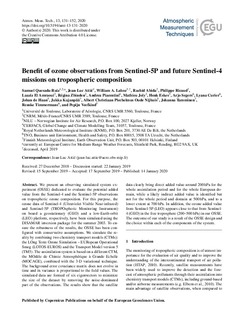| dc.contributor.author | Quesada-Ruiz, Samuel | |
| dc.contributor.author | Attié, Jean-Luc | |
| dc.contributor.author | Lahoz, William A. | |
| dc.contributor.author | Abida, Rachid | |
| dc.contributor.author | Ricaud, Philippe | |
| dc.contributor.author | El Amraoui, Laaziz | |
| dc.contributor.author | Zbinden, Regina | |
| dc.contributor.author | Piacentini, Andrea | |
| dc.contributor.author | Joly, Mathieu | |
| dc.contributor.author | Eskes, Henk | |
| dc.contributor.author | Segers, Arjo | |
| dc.contributor.author | Curier, Lyana | |
| dc.contributor.author | de Haan, Johan | |
| dc.contributor.author | Kujanpää, Jukka | |
| dc.contributor.author | Nijhuis, Albert C. P. O. | |
| dc.contributor.author | Tamminen, Johanna | |
| dc.contributor.author | Timmermans, Renske | |
| dc.contributor.author | Veefkind, Pepijn | |
| dc.date.accessioned | 2020-02-11T08:59:00Z | |
| dc.date.available | 2020-02-11T08:59:00Z | |
| dc.date.created | 2020-01-31T08:36:45Z | |
| dc.date.issued | 2020 | |
| dc.identifier.citation | Atmospheric Measurement Techniques. 2020, 13 131-152. | nb_NO |
| dc.identifier.issn | 1867-1381 | |
| dc.identifier.uri | http://hdl.handle.net/11250/2640929 | |
| dc.description.abstract | We present an observing simulated system experiment (OSSE) dedicated to evaluate the potential added value from the Sentinel-4 and the Sentinel-5P observations on tropospheric ozone composition. For this purpose, the ozone data of Sentinel-4 (Ultraviolet Visible Near-infrared) and Sentinel-5P (TROPOspheric Monitoring Instrument) on board a geostationary (GEO) and a low-Earth-orbit (LEO) platform, respectively, have been simulated using the DISAMAR inversion package for the summer 2003. To ensure the robustness of the results, the OSSE has been configured with conservative assumptions. We simulate the reality by combining two chemistry transport models (CTMs): the LOng Term Ozone Simulation - EURopean Operational Smog (LOTOS-EUROS) and the Transport Model version 5 (TM5). The assimilation system is based on a different CTM, the MOdele de Chimie Atmospherique a Grande Echelle (MOCAGE), combined with the 3-D variational technique. The background error covariance matrix does not evolve in time and its variance is proportional to the field values. The simulated data are formed of six eigenvectors to minimize the size of the dataset by removing the noise-dominated part of the observations. The results show that the satellite data clearly bring direct added value around 200 hPa for the whole assimilation period and for the whole European domain, while a likely indirect added value is identified but not for the whole period and domain at 500 hPa, and to a lower extent at 700 hPa. In addition, the ozone added value from Sentinel-5P (LEO) appears close to that from Sentinel-4 (GEO) in the free troposphere (200-500 hPa) in our OSSE. The outcome of our study is a result of the OSSE design and the choice within each of the components of the system. | nb_NO |
| dc.language.iso | eng | nb_NO |
| dc.rights | Navngivelse 4.0 Internasjonal | * |
| dc.rights.uri | http://creativecommons.org/licenses/by/4.0/deed.no | * |
| dc.title | Benefit of ozone observations from Sentinel-5P and future Sentinel-4 missions on tropospheric composition | nb_NO |
| dc.type | Journal article | nb_NO |
| dc.type | Peer reviewed | nb_NO |
| dc.description.version | publishedVersion | nb_NO |
| dc.rights.holder | © Author(s) 2020 | nb_NO |
| dc.source.pagenumber | 131-152 | nb_NO |
| dc.source.volume | 13 | nb_NO |
| dc.source.journal | Atmospheric Measurement Techniques | nb_NO |
| dc.identifier.doi | 10.5194/amt-13-131-2020 | |
| dc.identifier.cristin | 1787438 | |
| dc.relation.project | ESA - den europeiske romfartsorganisasjonen: 40000105743/11/NL/AF | nb_NO |
| cristin.unitcode | 7460,54,0,0 | |
| cristin.unitname | By og industri | |
| cristin.ispublished | true | |
| cristin.fulltext | original | |
| cristin.qualitycode | 1 | |

